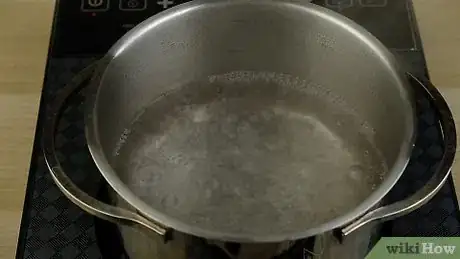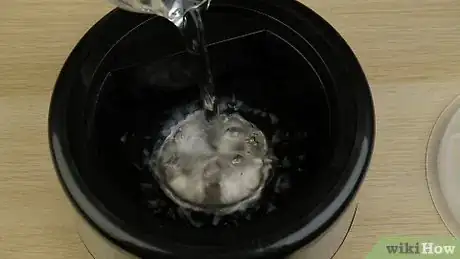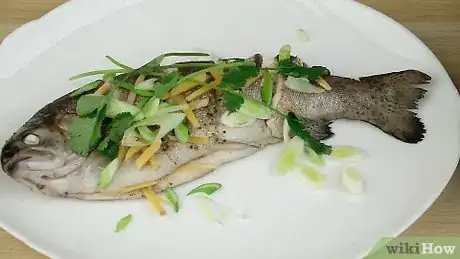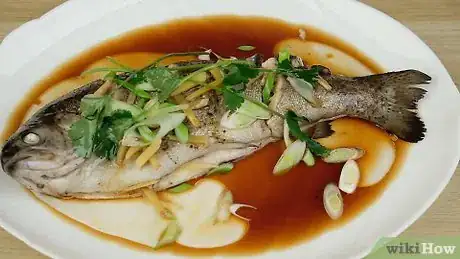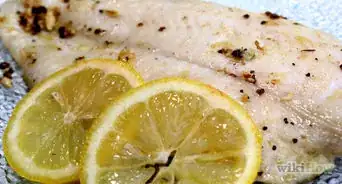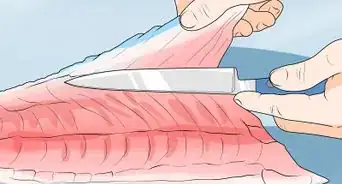This article was co-authored by wikiHow staff writer, Jessica Gibson. Jessica Gibson is a Writer and Editor who's been with wikiHow since 2014. After completing a year of art studies at the Emily Carr University in Vancouver, she graduated from Columbia College with a BA in History. Jessica also completed an MA in History from The University of Oregon in 2013.
There are 10 references cited in this article, which can be found at the bottom of the page.
The wikiHow Video Team also followed the article's instructions and verified that they work.
This article has been viewed 37,124 times.
Learn more...
If you have a steamer, you already have a jump on getting a nutritious meal on the table in no time. You can use fish fillets if you prefer, or you can cook the fish whole if it will fit in the steamer. Since steamed fish has a delicate flavor, it's easy to season it with aromatic flavors, such as lemon, ginger, and soy sauce. Play around to find your favorite steamed fish combinations.
Ingredients
- Two 3⁄4 pound (340 g) fish fillets
- 1 lemon, sliced
- 1 small red chili, sliced
- 1 tablespoon (6 g) of freshly grated ginger
- 1 tablespoon (15 ml) of rice vinegar
- 2 tablespoons (32 g) of hoisin sauce
- Kosher salt and freshly ground black pepper to taste
Makes 2 servings
- A 1 1⁄2 pounds (0.68 kg) whole white fish, cleaned and gutted
- A 1 in (2.5 cm) piece of fresh ginger, peeled and finely julienned
- 1⁄4 cup (59 ml) of light soy sauce
- 1 tablespoon (15 ml) of rice wine
- 1 tablespoon (15 ml) of water
- 1 scallion, julienned
- 4 fresh cilantro sprigs
- 1⁄4 cup (59 ml) of canola oil
- Kosher salt and freshly ground black pepper to taste
Makes 2 to 4 servings
Steps
Making Steamed Fillets in a Bamboo Steamer
-
1Heat a pot of boiling water on the stove. Fill the pot about half full with water and turn the burner to high. Place a lid on the pot so the water begins to boil faster. You'll see steam escape from under the lid once the water boils.[1]
- The bamboo steamer should fit snugly on the top of the pot.
- Ensure that the bottom of the steamer doesn't touch the water.
-
2Sprinkle both sides of the fillets with salt and pepper. Lay two 3⁄4 pound (340 g) fish fillets on a cutting board and sprinkle them with salt and pepper. Turn the fillets over and season them with more salt and pepper according to your taste.[2]
- Use any type of fish. Try basa, cod, halibut, branzino, or flounder, for instance.
- You can steam a whole fish in the bamboo steamer as long as it fits.
Advertisement -
3Put the fillets on a plate and lay the lemon, chili, and ginger over them. Get out a heatproof plate that will fit inside your bamboo steamer. Lay the fillets on it and arrange 1/2 of a sliced lemon and 1/2 of a sliced red chili over each fillet. Then, spread 1/2 tablespoon (3 g) of grated ginger across each fillet.[3]
- Feel free to season the fillets any way you like. You could use a ginger-soy sauce, for instance.
-
4Place the plate into the steamer basket and set it on the pot of water. Put the plate with the seasoned fish in the basket and put the tight-fitting lid on the steamer basket. Set the entire steamer basket on top of the pot of boiling water.[4]
Tip: It's important to use a steamer basket that has a tight-fitting lid so the steam doesn't escape.
-
5Steam the fish over medium heat for 8 to 10 minutes. Turn the burner down so the water simmers under the steamer basket. Heat the fish until it's opaque and cooked throughout.[5]
- To test if the fish is done, drag the tines of a fork over the center of a fillet. It should flake easily. If it doesn't, steam the fish for another minute and check it again.
-
6Microwave the rice vinegar and hoisin sauce for 10 seconds. If you'd like to make a flavorful sauce to pour over the fish, put 1 tablespoon (15 ml) of rice vinegar and 2 tablespoons (32 g) of hoisin sauce into a microwave-safe bowl. Heat the mixture for about 10 seconds so it's steaming hot.[6]
- If you don't want to serve the fish with the sauce, skip this step.
-
7Transfer the fish to a serving platter and pour the hot mixture over it. Carefully remove the lid from the steamer and move the steamed fish fillets to a serving platter. Pour the hot vinegar sauce over the fish and serve it immediately.[7]
- Refrigerate leftover steamed fish in an airtight container. Use the fish within 4 days.
Cooking Whole Fish in an Electric Steamer
-
1Fill the electric steamer with water and plug it in. Fill a pitcher with water and slowly pour it into the base of your electric steamer until the water reaches the maximum fill line. Then, place the drip tray on the water tank and plug in the machine. Depending on the type of steamer you have, it will probably turn on when you plug it in. If it doesn't, switch it on.[8]
- Always follow the manufacturer's instructions when you operate the steamer.
- Avoid overfilling the steamer or the machine might not work properly.
-
2Season the fish with salt and pepper and cut diagonal slashes across the fish. Lay a 1 1⁄2 lb (0.68 kg) whole white fish on your cutting board and sprinkle salt and pepper over it. Then, take a sharp knife and carefully score both sides of the fish. Make 3 diagonal slits that are about 1 inch (2.5 cm) apart.[9]
- Use any white fish, such as sea bass, branzino, or flounder.
- Scoring the fish helps it steam evenly and allows the flavor to penetrate the fish.
-
3Lay the fish in a steamer tray and season it with ginger. Get out the steamer tray that came with your electric steamer and place the fish in it. Take 1/2 of the 1 in (2.5 cm) piece of julienned ginger and put it inside the fish. Arrange the rest of it on top of the fish.[10]
- If you have a stackable electric steamer, ensure that you're using the bottom steamer tray.
Tip: If you'd like to steam fillets in the electric steamer, lay them across 1 of the steamer trays. Begin checking the fillets after steaming them for 5 minutes since they'll cook faster than a whole fish.
-
4Cover the steamer tray and set the timer for 8 to 9 minutes. Steam the fish until it flakes easily when you drag the tines of a fork over the center. Look at the flesh that's close to the center bones to see if they're opaque. If the fish isn't done, let it steam for another minute before checking again.[11]
- Stop steaming the fish before it dries out or your fish won't be tender.
- If you're steaming additional trays of food, stack them on top of the salmon before you cover it.
-
5Whisk the soy sauce, wine, and 1 tablespoon (15 ml) of water. Pour 1⁄4 cup (59 ml) of light soy sauce into a small bowl and add 1 tablespoon (15 ml) of rice wine along with 1 tablespoon (15 ml) of water. Whisk until the liquids are combined and set the bowl aside while the fish finishes steaming.[12]
- If you don't want to make an aromatic sauce, skip this step.
-
6Remove the fish from the steamer and arrange cilantro with scallions on top. Once the fish is steamed to your liking, carefully lift the tray out of the machine. Transfer the fish to a serving platter and scatter a julienned scallion over it. Then, place 4 fresh cilantro sprigs over the fish.[13]
- Discard any liquid that surrounds the fish in the steamer tray.
-
7Heat 1⁄4 cup (59 ml) of canola oil until it's hot. Pour the oil into a small pan and turn the burner to medium-high. Let the oil heat for a few minutes so it becomes hot and shimmery. Then, turn off the burner.[14]
-
8Pour the sauce over the fish along with the hot oil. Pour the reserved soy sauce mixture over the steamed fish. Slowly pour the hot oil over the aromatics on top of the fish so they soften and release their flavor. Then, serve the steamed fish.
- Refrigerate leftover fish in an airtight container for up to 4 days.
Warnings
- Use caution around the steam since it can burn you. Wear oven mitts when removing the steamer lid.⧼thumbs_response⧽
Things You'll Need
Steaming Fillets in a Bamboo Steamer
- Bamboo steamer
- Pot
- Heatproof plate
- Knife and cutting board
- Small microwave-safe bowl
Making Whole Fish in an Electric Steamer
- Knife and cutting board
- Electric steamer
- Measuring cups and spoons
- Spoon
- Small bowl
- Whisk
- Small pan
References
- ↑ https://www.foodnetwork.com/recipes/food-network-kitchen/steamed-fish-with-ginger-recipe-1973009
- ↑ https://youtu.be/-SF_ILNXX2g?t=16
- ↑ http://www.flavorquotient.com/2013/08/steamed-fish-with-lemon-ginger-and-chilli/
- ↑ https://youtu.be/-SF_ILNXX2g?t=27
- ↑ http://www.flavorquotient.com/2013/08/steamed-fish-with-lemon-ginger-and-chilli/
- ↑ http://www.flavorquotient.com/2013/08/steamed-fish-with-lemon-ginger-and-chilli/
- ↑ https://youtu.be/-SF_ILNXX2g?t=59
- ↑ https://youtu.be/Z_TBPomRWNg?t=43
- ↑ https://youtu.be/HpwHzpjTqYQ?t=119
- ↑ https://www.epicurious.com/recipes/food/views/steamed-whole-fish-with-ginger-scallions-and-soy-51115200
- ↑ https://thewoksoflife.com/steamed-whole-fish/
- ↑ https://www.epicurious.com/recipes/food/views/steamed-whole-fish-with-ginger-scallions-and-soy-51115200
- ↑ https://www.epicurious.com/recipes/food/views/steamed-whole-fish-with-ginger-scallions-and-soy-51115200
- ↑ https://www.foodnetwork.com/recipes/steamed-striped-bass-with-ginger-and-scallions-7112931
